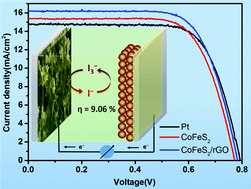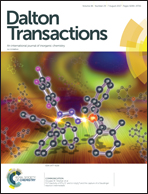A hierarchical CoFeS2/reduced graphene oxide composite for highly efficient counter electrodes in dye-sensitized solar cells†
Abstract
Transition metal sulfides are a kind of potential candidates for efficient and stable CE materials in DSSCs due to their good electrocatalytic ability and stability towards I3− reduction. However, the low conductivity of sulfides is harmful for the electron collection and transfer process, and the absorption/desorption and diffusion process of I−/I3− should be optimized to achieve high electrocatalytic activity over Pt. Herein, a hierarchical CoFeS2/reduced graphene oxide (CoFeS2/rGO) composite was rationally designed and prepared via the in situ conversion of CoFe layer double hydroxide anchored on rGO. Due to the synergistic effects of Co and Fe, unique 3D hierarchical structures formed by nanosheets, and the conductivity of rGO, the CoFeS2/rGO CEs exhibited good electrocatalytic activity and stability towards the reduction of I3− to I−, and the DSSCs could also achieve a high efficiency of 8.82%, higher than those of the devices based on Pt (8.40%) and pure CoFeS2 (8.30%) CEs. Moreover, the devices also showed the characteristics of fast activity onset, good stability, and high multiple start/stop capability. The results indicated that the developed CoFeS2/rGO composite could be a promising alternative for Pt in DSSCs.



 Please wait while we load your content...
Please wait while we load your content...